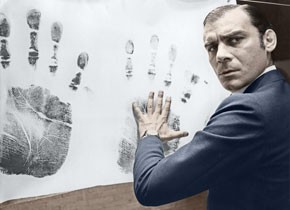Thriller Politics
Italy, France, and the Seventies
January 9 to February 6, 2014
The January program of the Film Museum is dedicated to a genre that played a defining role in Italian and French cinema of the late sixties and seventies, but which has since then been largely forgotten, and even somewhat discredited: the political thriller.
Individual works by the genre's Italian masters such as Damiano Damiani and Francesco Rosi were included in earlier Film Museum programs while a third, Elio Petri, had his own retrospective. However, it was the homage to Dominik Graf in the spring of 2012 that ultimately led to the development of this current project: Graf's enthusiasm for the Italian and French genealogies in this genre created the desire to once again engage with "thriller politics" (and to cross borders) – and also to dedicate a separate series to the genre's fourth key figure in Italy, Gillo Pontecorvo.
Up until the 1980s, films like The Assassination (Yves Boisset), Z (Costa-Gavras), Battle of Algiers (Pontecorvo), The Day of the Owl (Damiani), Cadaveri Eccellenti (Rosi), Investigation of a Citizen Above Suspicion (Petri) and I As In Icarus (Henri Verneuil) were beloved by cinephiles and the general public. Their mix of craftsmanship and propaganda was considered a perfect example of what movies can do as a popular art form. It was a genre whose characters one wanted to identify with: the police commissioner transferred to the boonies who singlehandedly fought against organized crime; the loners who more or less intentionally stuck their hands into wasp's nests of corruption; desperate lawyers and judges who found themselves in foggy gray zones where "left and right" and "right and wrong" had long since lost any meaning – a territory of zero visibility.
At times these films seemed to be thinly disguised versions of current political affairs: daily headlines were provided by coup attempts and secret organizations, attacks by fascists and the radical left, kidnappings and executions of hated politicians and activists in the streets (including Giuseppe Fava, author of the original material for Florestano Vancini's La violenza: Quinto potere, 1972). Terrorism entered into daily life: in Italy alone, several hundred people were killed in bomb attacks during the 1960s and 1970s, while veritable massacres in ultra-authoritarian France were open secrets. Although it was clear that there were specific national agendas and forms of terror, border-crossing alliances were daily occurrences – the undergrounds of the left as well as the right were (and are) connected through world-wide networks.
In both Italy and France, the problematic treatment of national history did the rest: fascism and collaboration became stylized taboos; attempts to critically examine the past were suppressed, if necessary, by state force. Right-wing discourses accompanied by revanchism took hold again with frightening speed – and the radical left's answers were not long in coming. In addition, there was a growing awareness of the disastrous entanglements of state, capital, and the underworld: in Italy, the reconstruction of the country and economy was inseparably tied to the penetration of the community by organized crime, which also played a decisive (shadow) role in the anti-communist struggles of the Cold War.
In Italy, the first examples of this popular cinema of political intervention can be found early on – principally in the films of Luigi Zampa and Francesco Rosi during the 1950s and early 1960s. However, it took the wholesale radicalization of society at large and heightened contradictions to create the necessary foundation for the genre – a constantly escalating anger over the ever-more obvious lies and monstrosities that were brought to light about various states as well as Western democracy itself. The tremendous success of Costa-Gavras' true-crime-lesson, Z (1969), as well as the first adaptations of the novels by Sicilian author Leonardo Sciascia (via Petri and Damiani) demonstrated that the genre's moment had arrived.
How threatening these films were to those in power can be derived from their production and distribution contexts – Yves Boisset, for example, would become the most censored film director of the Fifth Republic. Nearly all of his works that are being shown during this exhibition were at least partially obstructed by state authorities; The Assassination (1972) had to be filmed in neutral Switzerland to escape direct control by the French authorities – and still, Boisset found bullets in his mailbox. By 1980, it seemed that everything had been said about power and its costs, the situation had been sufficiently portrayed, the guilty had been named (mostly à clef) – yet nothing seemed to change. The armed resistance of the Italian Left squandered the remarkable tolerance shown at first by large sections of the population. The police were no longer trusted by anyone in France or in Italy. In his Kafkaesque manner, Henri Verneuil created I As In Icarus as a kind of cenotaph. The political thriller was driven underground.
We are pleased to welcome Dominik Graf to Vienna for the first weekend of this exhibition – many of the films to be screened represent a decisive influence in his work. The retrospective, supported by the Italian Cultural Institute, was co-curated by Olaf Möller.
Related materials
Photos 2014 - Dominik Graf


